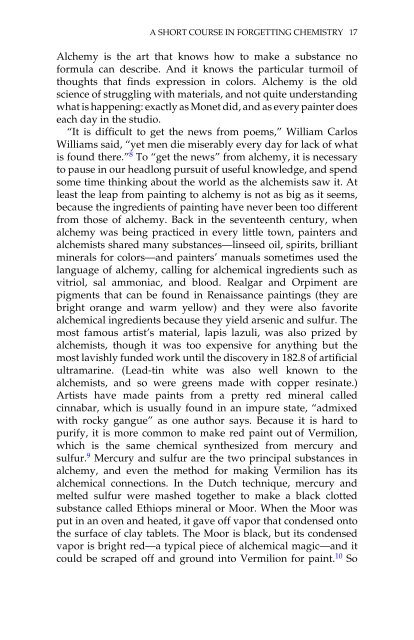What Painting Is: How to Think about Oil Painting ... - Victoria Vesna
What Painting Is: How to Think about Oil Painting ... - Victoria Vesna
What Painting Is: How to Think about Oil Painting ... - Victoria Vesna
You also want an ePaper? Increase the reach of your titles
YUMPU automatically turns print PDFs into web optimized ePapers that Google loves.
A SHORT COURSE IN FORGETTING CHEMISTRY 17<br />
Alchemy is the art that knows how <strong>to</strong> make a substance no<br />
formula can describe. And it knows the particular turmoil of<br />
thoughts that finds expression in colors. Alchemy is the old<br />
science of struggling with materials, and not quite understanding<br />
what is happening: exactly as Monet did, and as every painter does<br />
each day in the studio.<br />
“It is difficult <strong>to</strong> get the news from poems,” William Carlos<br />
Williams said, “yet men die miserably every day for lack of what<br />
is found there.” 8 To “get the news” from alchemy, it is necessary<br />
<strong>to</strong> pause in our headlong pursuit of useful knowledge, and spend<br />
some time thinking <strong>about</strong> the world as the alchemists saw it. At<br />
least the leap from painting <strong>to</strong> alchemy is not as big as it seems,<br />
because the ingredients of painting have never been <strong>to</strong>o different<br />
from those of alchemy. Back in the seventeenth century, when<br />
alchemy was being practiced in every little <strong>to</strong>wn, painters and<br />
alchemists shared many substances—linseed oil, spirits, brilliant<br />
minerals for colors—and painters’ manuals sometimes used the<br />
language of alchemy, calling for alchemical ingredients such as<br />
vitriol, sal ammoniac, and blood. Realgar and Orpiment are<br />
pigments that can be found in Renaissance paintings (they are<br />
bright orange and warm yellow) and they were also favorite<br />
alchemical ingredients because they yield arsenic and sulfur. The<br />
most famous artist’s material, lapis lazuli, was also prized by<br />
alchemists, though it was <strong>to</strong>o expensive for anything but the<br />
most lavishly funded work until the discovery in 182.8 of artificial<br />
ultramarine. (Lead-tin white was also well known <strong>to</strong> the<br />
alchemists, and so were greens made with copper resinate.)<br />
Artists have made paints from a pretty red mineral called<br />
cinnabar, which is usually found in an impure state, “admixed<br />
with rocky gangue” as one author says. Because it is hard <strong>to</strong><br />
purify, it is more common <strong>to</strong> make red paint out of Vermilion,<br />
which is the same chemical synthesized from mercury and<br />
sulfur. 9 Mercury and sulfur are the two principal substances in<br />
alchemy, and even the method for making Vermilion has its<br />
alchemical connections. In the Dutch technique, mercury and<br />
melted sulfur were mashed <strong>to</strong>gether <strong>to</strong> make a black clotted<br />
substance called Ethiops mineral or Moor. When the Moor was<br />
put in an oven and heated, it gave off vapor that condensed on<strong>to</strong><br />
the surface of clay tablets. The Moor is black, but its condensed<br />
vapor is bright red—a typical piece of alchemical magic—and it<br />
could be scraped off and ground in<strong>to</strong> Vermilion for paint. 10 So


